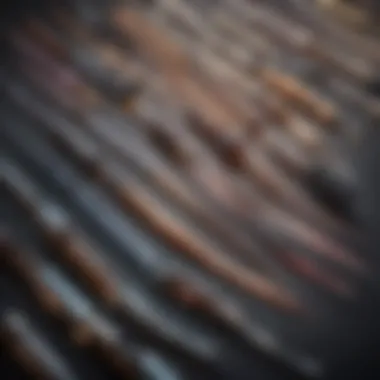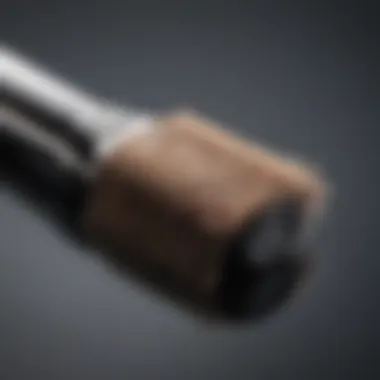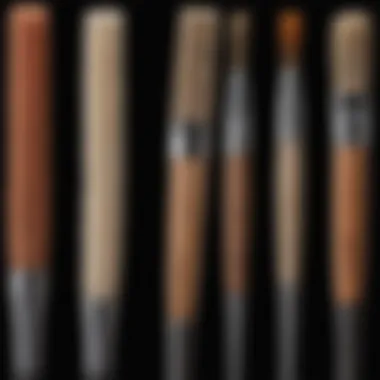Choosing the Ideal Nail Brush for Acrylic Artistry


Intro
Choosing the right nail brush is essential for achieving the perfect acrylic nails. Many people focus on the color of the polish or the nail shape while overlooking the brush's importance. Nail brushes are critical tools, and selecting the best one can significantly enhance application precision and overall nail art quality.
This guide will provide insight into various aspects of nail brushes for acrylic nails. Readers will explore different types of brushes, suitable materials, and their bristle configurations. Furthermore, practical tips and recommendations will aid both novices and seasoned professionals in choosing wisely.
Understanding Nail Brush Types
Not all brushes are created equal. Different shapes and sizes serve distinct purposes during the nail application process.
- Flat Brushes: These brushes are ideal for creating a smooth base. They deposit product evenly and are great for large surface areas.
- Round Brushes: These are versatile and perfect for detail work. They allow for precision when applying intricate designs or when working on cuticles.
- Detailing Brushes: These have fine tips suited for creating delicate patterns. They require steady hands for intricate designs.
Each brush type serves a specific purpose, depending on the desired outcome. The selection must align with the user's skill level and the complexity of the desired nail art.
Evaluating Materials
The materials used in nail brushes impact their application and durability. Common materials include:
- Synthetic Bristles: These brushes are often made from nylon or polyester. They are widely used because they are easy to clean and maintain, and they offer a stiff yet flexible feel that works well with acrylics.
- Natural Hair Bristles: Brushes made from natural hair tend to hold more liquid. However, they might be less durable when used with acrylics compared to synthetic options. These are better suited for specific nail art techniques.
When selecting a brush, consider how often it will be used and the types of products it will come in contact with. This can guide choices between synthetic and natural options.
Assessing Bristle Configurations
The configuration of bristles can affect both the application and the outcome. A well-designed brush should allow smooth application and efficient product dispersion. Look for:
- Weft Density: Denser bristles may hold more product, while loosely packed bristles can provide more flexibility.
- Length: Longer bristles can be advantageous for sweeping applications, while shorter bristles offer more control for detailing.
Epilogue
Preamble to Nail Brushes
In the realm of nail care and art, the selection of an appropriate nail brush cannot be overstated. Nail brushes play a pivotal role in the application process, influencing not only the ease of use but also the final outcome of the acrylic nails. The choice of brush can affect the precision of detail work and the overall finish, making it a crucial element for both beginners and seasoned professionals.
Purpose of Nail Brushes
Nail brushes serve a variety of functions, each designed for specific tasks within the acrylic application process. Their main purpose is to facilitate the even application of acrylic products. A good brush can help in achieving smooth finishes and precise lines, essential for intricate designs. Additionally, different brush types cater to various techniques, allowing artists to express their creativity effectively. The purpose of these brushes extends beyond mere functionality; they shape the connection between the artist’s vision and the physical output on the nail.
Importance in Acrylic Applications
Acrylic applications demand a high level of finesse and skill. The proper brush aids in the manipulation of the acrylic material, which can behave differently based on the chosen tools. Using the right nail brush can greatly enhance the texture and control over the thickness of the acrylic layer.
For example, a detail brush is essential for fine work, while a flat brush can help in larger area coverage. Having the suitable brush allows for better product control, minimizing waste and enhancing the durability of the nail art. A well-selected nail brush not only improves the quality of the application but also boosts the efficiency of the process. Making an informed brush choice can lead to higher satisfaction for both the artist and the client.
Understanding Different Types of Nail Brushes
When selecting the best nail brush for acrylic nails, understanding the different types of brushes available is crucial. Each brush type serves a unique purpose and can significantly affect the application process and final results. Knowing the specific characteristics of each brush helps not only professionals but also novices in developing their skills. It allows for precision in design, and better control during application, and ultimately enhances the quality of the artwork on nails. Here we will explore four primary types of nail brushes often used in acrylic applications: detail brushes, flat brushes, fan brushes, and gel brushes. Each contributes to the overall aesthetic and functionality of nail art.


Detail Brushes
Detail brushes are essential for intricate designs. They typically have fine bristles that allow for precision work. Artists often use these brushes for creating fine lines, delicate patterns, and other detailed artwork. The key feature of a detail brush is its thinness, which can vary slightly depending on the brand. This enables users to achieve enhanced accuracy when reproducing small elements. Detail brushes are perfect for freehand designs and can elevate any nail art project.
Flat Brushes
Flat brushes are characterized by a square tip and are versatile tools in nail art. They are commonly used to create wide strokes, fill in larger areas, or produce a smooth base layer. Their flat bristles allow for even coverage and can help with gradient techniques. When working with acrylic, these brushes often help artists blend colors seamlessly and achieve a professional finish. The size can vary, providing options for different levels of detail needed in a design.
Fan Brushes
Fan brushes, as the name suggests, have bristles arranged in a fan shape. They are primarily used for texture effects on nails. With their unique configuration, they create smooth blends and can be utilized for various nail designs such as ombre or marble effects. The use of fan brushes can bring a dimensional aspect to nail art, giving it a more dynamic appearance. This type of brush is particularly useful for applying glitter and can also aid in achieving soft lines between colors.
Gel Brushes
Gel brushes are designed specifically for use with gel products, though they can also be useful for acrylic applications. They often feature stiffer bristles that hold product better without causing it to drip. Gel brushes are integral for applying and sculpting gel nails. The density allows for good control, making it easier to work with the product. Artists often use these brushes for building layers or getting the precise shapes needed for intricate designs.
Understanding these different types of brushes is vital in choosing the right tool for the desired effect. A well-selected brush not only aids in creating beautiful nails but also enhances the overall application experience.
Material Considerations for Nail Brushes
The material from which a nail brush is constructed plays a pivotal role in its performance, durability, and overall effectiveness in applying acrylic nails. Proper selection of brush materials can greatly influence the outcome of the manicure, affecting both the ease of application and the quality of the final product. Understanding these materials is crucial for both beginners and seasoned nail artists seeking precision and longevity in their work. Quality brushes can facilitate smoother application, better control, and ultimately lead to more visually appealing results.
Natural Hair Brushes
Natural hair brushes are made from animal hair fibers, often sourced from sable, pony, or kolinsky. Each type brings unique characteristics that affect the brush's performance. For example, kolinsky brushes are particularly renowned for their fine-point precision and ability to hold more product compared to synthetic options. This feature enables detailed work, especially when creating intricate designs or patterns.
However, the use of natural hair also poses ethical dilemmas for some consumers. Additionally, these brushes may require more maintenance to preserve their shape and effectiveness. Improper handling or cleaning can lead to damage, reducing the lifespan of the brush significantly. Despite these considerations, many professionals prefer them for their superior application capabilities.
Synthetic Brushes
Synthetic brushes use man-made fibers, crafted primarily from nylon or polyester. These materials are often less expensive than natural hair while providing consistent performance across a range of applications. Synthetic brushes have become increasingly popular due to their durability and ease of cleaning. They tend to resist damage from solvents, making them suitable for a variety of nail products, including acrylics.
Moreover, synthetic brushes offer a variety of shapes and sizes similar to their natural counterparts. They also do not carry the same ethical concerns, appealing to a wider audience. While they may not hold as much product as natural hair, advancements in material technology have largely closed this gap, giving users options that combine practicality with performance.
Comparative Analysis of Materials
When comparing natural and synthetic brushes, several factors come into play.
- Performance: Natural hair brushes often excel in detail work due to their ability to hold more liquid and create finer lines. However, synthetic brushes also perform well and may even be more reliable for broader applications.
- Durability: Synthetic brushes generally outperform natural brushes in terms of longevity, especially when exposed to chemical products.
- Cost: Synthetic brushes are typically more affordable than high-quality natural brushes, making them accessible for varying budgets.
- Maintenance: Synthetic brushes require less upkeep, while natural brushes need more care to maintain their shape and effectiveness.
Ultimately, the choice between natural and synthetic nail brushes depends on individual needs, ethics, and personal experiences. Understanding these materials allows nail technicians and enthusiasts alike to make informed decisions tailored to their specific applications.
Choosing the Right Size and Shape
Choosing the right size and shape of a nail brush is more than just a matter of preference; it directly impacts the quality and precision of acrylic nail applications. Each brush has a specific purpose, which can vary significantly based on the desired effect or technique. An improper choice can lead to unsatisfactory results, including uneven application and difficulties in achieving intricate designs. Therefore, understanding the nuances involved in selecting the appropriate size and shape is crucial for both hobbyists and professionals alike.
Optimal Sizes for Various Techniques
When it comes to nail brushes, size matters. Different techniques demand specific brush sizes to achieve optimal results. The following guideline provides an overview of optimal sizes:


- Detail Work: A smaller brush, like a size 00 or 0, is ideal for intricate designs. It allows for precision when crafting fine lines or detailed artwork.
- Medium Applications: For general acrylic application, a size 6 or 8 brush is effective. It covers a decent area while still allowing for some control.
- Large Areas: When creating an overtly broad base or a solid color, larger brushes, such as size 10 or above, expedite the process without compromising quality.
Assessing the specific technique needed for application will aid in determining the optimal brush size, preventing excessive strokes or uneven layers of acrylic.
Effects of Brush Shape on Application
The shape of a nail brush influences not just the ease of application, but also the overall result. Understanding various shapes and their uses can enhance both efficiency and aesthetics:
- Flat Brushes: Best suited for applying large areas of acrylic, these brushes enable an even and smooth application. They are particularly useful for the initial layering process.
- Round Brushes: These are versatile and can be used for both detail work and broader strokes. Their shape allows for flexibility in technique, making them a popular choice among nail artists.
- Angle Brushes: The angled cut helps in creating defined edges, essential for certain styles, like the French tips.
Evaluating Bristle Configuration
Understanding the bristle configuration of a nail brush is key to achieving precise application and artistry in acrylic nail techniques. The arrangement of bristles affects the way products are picked up, delivered, and spread across the nail surface. Consequently, it is essential for both novices and experienced technicians to consider various aspects of bristle configuration when selecting a brush.
Density and Firmness
Density refers to the number of bristles in a brush, while firmness relates to how stiff or flexible those bristles are. These two characteristics work together to influence the brush's functionality.
- Brushes with high density often hold more acrylic or gel product. This means they are capable of covering larger areas without needing to dip back into the product frequently.
- A firmer brush may be ideal for pushing and placing product precisely, especially in tight corners or when creating intricate designs. Conversely, softer brushes are suited for blending and feathering, which are essential skills in nail art.
Choosing the right density and firmness depends largely on the technique being executed. For example, when sculpting acrylics, a firmer, denser brush allows for better control, while blend-heavy nail artworks benefit from softer bristles that provide a seamless finish.
Bristle Arrangement Patterns
The arrangement patterns of bristles also significantly impact the performance of the brush. Different patterns serve various purposes in application techniques.
- Flat Arrangements: These brushes are optimal for even application of product over large areas. Their design allows for an easy glide, ensuring smooth layers.
- Round Shapes: A round brush enhances precision and is especially useful for detailing work, allowing you to navigate around curves and cuticles effectively.
- Angled Designs: Brushes with an angle can simplify the process of creating clean lines and edges. They are particularly effective for cut-out designs and can help minimize mistakes.
In summary, evaluating the density, firmness, and arrangement of bristles in a nail brush is critical. This assessment enables selection based on specific project needs, enhancing the quality of nail artistry and the overall efficiency of application techniques. By paying close attention to these details, one can elevate the standard of acrylic nail designs.
Popular Brands in Nail Brushes
When choosing a nail brush for acrylic nails, the brand can heavily influence a user's experience and results. The right brand can ensure quality products that withstand regular use. Many brands specialize in provide tools specifically tailored for nail art. This section will cover significant factors that come into play when evaluating popular brands in nail brushes.
Brand Overview
Several established brands dominate the nail brush market, each known for its unique features and target audience. Some well-known names include:
- CND: Known for its high-quality materials and innovative designs, CND brushes are a favorite among professionals. Their attention to detail makes them ideal for intricate work.
- O.P.I: This brand is renowned not just for its nail polish but also offers excellent nail brushes. O.P.I focuses on user-friendly tools that help achieve a salon finish at home.
- Mia Secret: A brand that caters to both beginners and experienced nail technicians. Mia Secret provides a range of brushes that offer great value without compromising on quality.
- Alpha Brush: Catering primarily to professionals, Alpha Brush is trusted for its durability and performance in demanding environments.
These brands often collaborate with nail artists to develop tools that meet specific needs of their users, ensuring satisfaction and quality application.
Comparative Quality Assessment
When assessing the quality of nail brushes from different brands, it becomes clear that significant differences exist. Factors to evaluate include:
- Material Quality: The bristles of the brush should be made from either natural or synthetic fibers. Natural hair brushes, for instance, can offer better paint holding capacity but might not be durable under extensive use. Synthetic brushes are usually more resistant to wear.
- Construction and Design: A well-designed brush should feel comfortable in hand and offer good control. Top brands typically have ergonomic handles that reduce fatigue during long sessions.
- Performance: A brush must not only apply product effectively but also maintain its shape. Reviews and user feedback are invaluable in this assessment.
- Price Point: While a higher price might indicate better quality, some affordable options can outperform expensive counterparts. Consumers should weigh their needs and budget carefully.
Maintenance and Care for Nail Brushes


Maintaining and caring for nail brushes is crucial for anyone using acrylic for nail art. Proper care extends the life of these tools, which ultimately affects the quality of applications. A well-maintained brush ensures smoother strokes, precise detailing, and less hassle when working on intricate designs. Investing time and effort into brush maintenance can significantly enhance your overall nail artistry, minimizing issues such as uneven application and brush fraying.
Cleaning Techniques
Cleaning techniques for nail brushes require some attention. It's essential to use the right cleaning methods to remove acrylic residue without damaging the bristles. Here are a few effective techniques:
- Use a Brush Cleaner: Special brush cleaners are available that dissolve acrylic without harming the brush. Apply a small amount to a clean towel and gently wipe the brush, working from the bristle base to the tip.
- Soaking in Monomer: For tough residue, a brief soak in monomer can help dissolve leftover materials. Always rinse thoroughly afterward to prevent product buildup. Be cautious not to soak the brush for too long, as this can cause damage.
- Regular Cleaning Routine: Make it a habit to clean brushes immediately after use. This prevents product hardness, making future cleaning efforts more manageable.
"Addressing brush maintenance properly can reduce the need for frequent replacements and improve your results."
Proper Storage Guidelines
Proper storage is just as important as cleaning. How you store your nail brushes affects their longevity and effectiveness. Consider these guidelines for best results:
- Flat Storage: Store brushes flat in a drawer to avoid bending the bristles. This position helps them maintain their original shape.
- Use Brush Holders: Many tools are available that feature compartments designed specifically for brushes. These holders can keep brushes separated, reducing the chance of damage from friction.
- Avoid Heat Sources: Always keep brushes away from direct sunlight and heat. Heat can alter the shape and texture of the bristles, which ultimately affects performance.
- Keep Away from Contaminants: Ensure brushes are stored in a clean area. Keeping them away from dust and other contaminants will help maintain their condition and ensure a quality application every time.
Ultimately, being diligent with maintenance and care for nail brushes is fundamental for anyone serious about acrylic nail art. Taking these steps can lead to better results and a more enjoyable art experience.
Common Mistakes to Avoid
Avoiding common pitfalls can greatly enhance your experience and results when working with acrylic nails. Understanding these mistakes not only saves time and effort but also increases the longevity and quality of your nail designs. Here, we will explore two frequent errors: misjudging brush quality and neglecting proper maintenance.
Misjudging Brush Quality
One of the significant missteps in selecting a nail brush is assuming all brushes are of equal quality. The market presents an array of brushes, but not all are capable of achieving professional results, especially in acrylic applications. Investing in a high-quality brush can drastically influence your nail art precision and application ease.
When assessing brush quality, consider the bristle type, their density, and overall construction. Natural hair brushes, for instance, often provide better control and smoother application compared to synthetic ones. They are capable of holding more product, allowing for seamless blending and a polished finish. On the other hand, poor-quality brushes may shed bristles or warp, hindering your efforts and ultimately leading to frustration.
Additionally, brand reputation plays an important role. Established brands like Kolinsky, for instance, are known for their superior products. If you prioritize price over quality, you may end up with a brush that does not perform well, adding time and effort to your acrylic tasks.
Neglecting Proper Maintenance
Proper care and maintenance of your brushes cannot be overstated. Many individuals overlook this aspect, which can lead to subpar application and even damage the brush over time. Failing to clean the brushes after every use allows acrylic residue to build up, compromising the bristles and altering their performance.
To maintain your brush effectively, use a suitable cleaner specifically designed for acrylic products. Do not simply rinse with water, as it may not dissolve all product residue. Moreover, store your brushes in a manner that protects the bristles from bending or splaying. Keeping them in a case or a holder can extend their lifespan significantly.
In summary, understanding and avoiding these mistakes can make a marked difference in your acrylic nail application. Prioritize quality in your brush selection and maintain them diligently to ensure the best results in your nail art endeavors.
End and Final Thoughts
In this section, we will synthesize the vital points addressed throughout the article regarding nail brushes specifically designed for acrylic nails. Selecting the right brush fundamentally impacts the quality and accuracy of application, making it critical for both professionals and enthusiasts alike. When considering your options, it is essential to reflect on the various types, size configurations, and bristle materials available, as each element contributes to the overall application process.
A well-chosen nail brush can enhance precision and elevate the aesthetic of acrylic designs.
Summary of Key Points
To summarize, the following key aspects have been highlighted:
- Diverse Types of Brushes: Understanding the different types of brushes—detail, flat, fan, and gel brushes—ensures that one selects the right tool for specific techniques.
- Material Considerations: Whether opting for synthetic or natural hair brushes, the materials used significantly impact brush performance and results.
- Size and Shape Factors: Identifying the optimal sizes and shapes based on the techniques employed can improve application efficiency.
- Bristle Configuration: Analyzing bristle density and arrangement aids in selecting brushes that meet personal preferences and artistic needs.
- Brand Reputation: Evaluating established brands can provide assurance of quality and reliability in brush performance.
- Maintenance Requirements: The correct cleaning and storage practices extend the life of brushes and maintain their effectiveness.
- Avoiding Common Mistakes: Recognizing and avoiding pitfalls in brush selection and care can prevent dissatisfaction and subpar application.
Encouragement for Informed Choices
As we conclude, it is crucial to emphasize the significance of making informed choices when selecting nail brushes for acrylic nails. Invest time in understanding your specific needs and preferences as an artist. Consider experimenting with different types and brands until you find what best suits your style. The investment in quality tools pays dividends in both performance and results.
It is beneficial to engage with fellow artists through platforms like Reddit, where sharing experiences can offer additional insights. Ultimately, the right brush not only elevates nail art but also enhances personal satisfaction with your work. Approach this selection process thoughtfully and with an open mind, and you will likely find the perfect brush to match your artistic vision.



